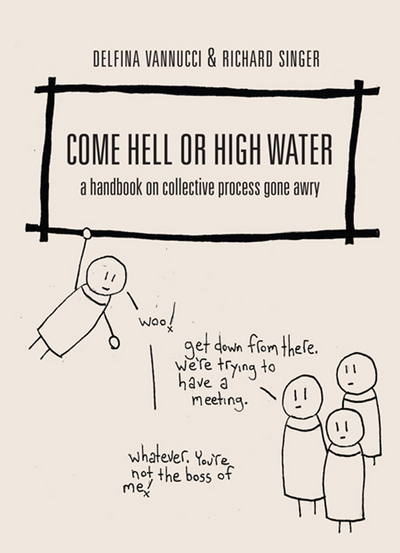If you want to live in a just and sustainable world (and who doesn’t?) then egalitarian collective process is unavoidable. Come Hell or High Water, is a much needed critical analysis of this process. The authors are careful to explain, “the purpose of this book is to clarify some of the problems that can come up in groups that strive for equality and openness.” It’s not an instructional manual, it’s a critique. And hey, if it’s worth critiquing, it’s worth practicing.
For someone who is immersed in collective organizing and is interested in the nuts and bolts of how it works, it’s refreshing to read an honest deconstruction of egalitarian collective process. The crux of collective process is handily summed up in the introduction:
“It’s a heady ideal. At its best, it stands as a model for a more just and inclusive structure for working and existing together… but… When the ideal of egalitarianism is allowed to flounder, unattended to, it can devolve right back into the patterns that most of us knew in our lives outside of collectives: hierarchy, mistrust, looking out only for oneself, and sometimes even underhanded scheming.”
Not always a fan of cynical wit and predictable DIY aesthetic, the style of the book almost lost me, seeming at first read, a trendy, bitter version of what I know and love as heart-felt community activism. In my experience, people come together around issues and projects they care passionately about and the genuine commitment to the work and to each other is what prevails despite messy collective process.
After tripping along through the warnings that egalitarian collectives are fraught with underhanded scheming for power and authoritarian motives disguised as innocent adherence to process, between repeated mention of the apparently common practice of “banning,” I must admit I was grumpy with what I felt was an unhelpfully negative spin. But, I appreciate that negativity has a place in light of too many starry-eyed idealists spouting egalitarian, anarchist propaganda. For me the message is; no matter how complicated, stressful or annoying collective organizing can be, come hell or high water, we won’t stop… so we might as well get better at it.
Insightful points, organized in lists with chapter headings such as, “Red Flags to Guard Against,” broken down into sub-categories, “group behaviours,” and, “individual behaviours,” are easy to read and return to. Another set of numbered points is titled, “Tactics Used to Subvert Democratic Process,” with the sub-headings, “at meetings,” and, “within the group’s larger dynamic.”
The comics illustrating “how to” subvert democratic process certainly make their point and made me want to run and find someone to share the joke with. A great section called “Model for Justice?” points out the popular misconception that anarchy is about rejecting any and all rules on principle or out of convenience, and how that attitude among some activists can undermine justice by preventing due process.
A section called “A Closer Look at Consensus” investigates the merits of voting as a method that allows dissent to be expressed and documented without members feeling they should suppress their reactions to avoid blocking consensus. A sub-title towards the end of the handbook, “Staying True to the Mission” under, “Making it Work,” recommends drafting a mission statement to refer back to whenever a decision needs to be made.
The last 10 pages are full of solutions and hope, explaining “cardinal points to keep in mind when conflict arises,” “codifying the collective process” with items like grievance procedures and defining membership. The handbook concludes with the bold heading, “THERE’S HOPE,” asserting that virtually all problems in collectives can be overcome by applying compassion. I might have got a bit bogged down in the muck of sections on bullying, hording information, slander and trickery, but in the end I am happy to have such a handy and thorough resource to refer to and to lend.
I think this book might prove frustrating or discouraging if read as a handbook to guide a collective through conflict or difficult times, or as a warning of what to watch out for. Instead I would read it as an affirmation that me, and my collective, are not alone, but are part of a long history and a powerful movement of people practicing direct democracy, or at least trying to. It would make a great choice for a book club or discussion group, since it’s short and concise, and directly relevant to a group setting.
I don’t doubt Delfina Vannucci and Richard Singer’s honourable efforts will inspire discussion, and hopefully more research and writing about the topic. After all, collective process is important, maybe even the most important thing, in our work towards social and environmental justice.—Sonia Edworthy
Sonia Edworthy is a community activist, gardener, support worker, artist. With a Bachelor of Community Design from the School of Urban Planning at Dalhousie University, and as co-founder of Anchor Archive Zine Library, Inkstorm Screenprinting Collective and Roberts Street Social Centre in Halifax, she enjoys collaborative projects, and collective process. Currently Son spends her time coordinating the Old Y Centre for Community Organizations in Calgary, Alberta.



